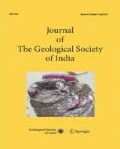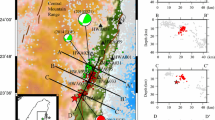Abstract
We have studied a moderate earthquake of February 06, 2017 occurred in Rudraprayag, Uttarakhand of northwest Himalaya that created prominent ground shakings not only around the epicentral region but also to far distances in different parts of the National Capital Territory (NCT) of Delhi, which is an unusual experience. Full waveform inversion and source study suggest, moment magnitude of the event to be Mw 5.5 with the centroid depth of 19 km. The waveform analysis also reveals the oblique faulting mechanism associated with the down-dip apex of the detachment. The source parameters, namely, source radius, stress drop, and seismic moment of the event have been estimated to be 2.3 km, 63 bars, and 2.05 E + 17N-M respectively. The epicenter of the event falls in the seismically active zone between two major thrusts of the Himalaya, viz., Main Boundary Thrust (MBT) and Main Central Thrust (MCT). In the present study, strong ground motion was simulated using Empirical Green’s Function (EGF) approach for a scenario earthquake of Mw6.8 magnitude in the same source, considering it similar to the Chamoli earthquake (M 6.8) of March 29, 1999 that had occurred in the neighborhood. The peak ground acceleration (PGA) has been estimated at the recording sites and a contour map is generated for the entire study region, covering the cities located up to ∼ 700 km from the source. The predicted strong ground motion varies between 22 gals to 352 gals within the epicentral region up to ∼ 150 km, which may lead to moderate to severe ground shaking. However, weak to light shaking expected in the remaining parts of the study region with PGA ranging between (0.50–22) gals.
Similar content being viewed by others
References
Benetatos, C., Málek, J., Verga, F. (2013) Moment tensor inversion for two micro-earthquakes occurring inside the Háje gas storage facilities, Czech Republic. Jour. Seismology, v.17, pp.557–577. doi: https://doi.org/10.1007/s10950-012-9337-0.
Boore, D. (2003) Simulation of Ground Motion Using the Stochastic Method. Pure Appl. Geophys, v.160, pp.635–676.
Brune, J.N. (1970) Tectonic stress and the spectra of seismic shear waves from earthquakes. Jour. Geophys. Res., v.75, pp.4997–5009.
Caldwell, W.B., Klemperer, S.L., Lawrence, J.F. et al., (2013) Characterizing the Main Himalayan Thrust in the Garhwal Himalaya, India with receiver function CCP stacking. Earth Planet Sci Lett, v.367, pp.15–27. doi: https://doi.org/10.1016/J.EPSL.2013.02.009.
Cattin, R., Avouac, J.P. (2000) Modeling mountain building and the seismic cycle in the Himalaya of Nepal. Jour. Geophys. Res., v.105, pp.13389–13407. doi: https://doi.org/10.1029/2000JB900032
Chopra, S., Kumar, V., Sutar, A., Kumar, P. (2012) Modeling of strong ground motions for 1991 Uttarkashi, 1999 Chamoli earthquakes, and a hypothetical great earthquake in Garhwal-Kumaun Himalaya. Nat Hazards, v.64, pp.1141–1159, doi: https://doi.org/10.1007/s11069-012-0289-z.
Gansser, A. (1964) The Geology of the Himalayas. Wiley Interscience, London, 289p.
Geller, R.S. (1976) Body force equivalents for stress drop seismic sources, Bull. Seism. Soc. Amer., v.66, pp.1801–1804.
Hartzell, S. (1978) Earthquake aftershocks as Green’s functions, Geophys. Res. Lett., v.5, pp.1–4
Havskov, J., Ottemoller, L. (2010) Routine data processing in earthquake seismology: with sample data, exercises and software. Springer, pp.347
Irikura, K. (1984) Prediction of strong ground motions using observed seismograms from small events. In: Proc. 8th World Conf. on Earthq. Eng. Vol. 2, pp 465–472
Irikura, K (1986) Prediction of strong acceleration motion using empirical Green’s function. In: Proc. 7th Japan Earthq. Eng. Synp. pp.151–156
Irikura K, Kagawa T, Sekiguchi H, et al. (1997) Revision of the empirical Green’s function method. Progr Abstr Seismol Soc Japan 2, pp.1–4
Jain, A.K. (1987) Kinematics of the transverse lineaments, regional tectonics and Holocene stress field in the Garhwal-Himalaya. Jour. Geol. Soc. India, v.30, pp.69–186.
Joshi, A. (2006) Analysis of strong motion data of the Uttarkashi earthquake of 20th October 1991 and the Chamoli Earthquake of 28th March 1999 for determining the Q value and source parameters. ISET Jour. Earthquake Tech., v.43, pp.11–29.
Kayal, J.R., Sing, O.P., Chakraborty, P.K. and Karunakaran, G. (2003) Aftershock sequence of the March 1999 Chamoli earthquake and the seismotectonic structure of the Garhwal Himalaya. Bull. Seism. Soc. Amer., v.93, pp.109–117.
Kennett, B.L.N., Engdahl, E.R. (1991) Traveltimes for global earthquake location and phase identification. Geophys. Jour., v.105, pp.429–465.
Kumar, N., Sharma, J., Arora, B.R., Mukhopadhyay, S. (2009) Seismotectonic model of the Kangra-Chamba sector of Northwest Himalaya: Constraints from joint hypocenter determination and focal mechanism. Bull. Seismol. Soc. Amer., v.99, pp.95–109. doi: https://doi.org/10.1785/0120080220.
Mahedh P., Gupta, S, Rai, S.S., Sharma, P.R. (2012) Fluid driven earthquakes in the Chamoli region, Garhwal Himalaya: Evidence from local earthquake tomogrphy. Geophys. Jour. Internat., v.191, pp.1295–1304.
Mukhopadhyay, S., Kayal, J.R. (2003) Seismic tomography structure of the 1999 Chamoli earthquake source area in the Garhwal Himalaya. Bull. Seismol. Soc. Amer., v.93, pp.1854–1861. doi: https://doi.org/10.1785/0120020130
Nath, S.K., Thingbaijam, K.K.S. (2009) Seismic hazard assessment — a holistic microzonation approach. Nat. Hazards Earth Syst. Sci., v.9, pp.1445–1459. doi: https://doi.org/10.5194/nhess-9-1445-2009
Ni, J.F., Barazangi, M. (1984) Seismotectonics of the Himalayan collision zone: Geometry of the underthrusting Indian Plate beneath the Himalaya. Jour. Geophys. Res., v.89, pp.1147–1163
Pandey, M.R., Tandukar, R.P., Avouac, J.P., et. al. (1995) Interseismic strain accumulation on the Himalayan crustal ramp (Nepal). Geophys. Res. Lett., v.22, pp.751–754.
Rawat, G., Arora, B.R., Gupta, P.K. (2014) Electrical resistivity cross-section across the Garhwal Himalaya: Proxy to fluid-seismicity linkage. Tectonophysics, v.637, pp.68–79. doi: https://doi.org/10.1016/j.tecto.2014.09.015
Seeber, L., Armbruster, J.G., Quittmeyer, R.C. (2013) Seismicity and Continental Subduction in the Himalayan Arc. In: H. K. Gupta and F. M. Delany (Eds.), Zagros Hindu Kush Himalaya Geodynamic Evolution. doi: https://doi.org/10.1029/GD003p0215.
Sharma, B., Chopra, S., Sutar, A.K. et al. (2013) Estimation of Strong Ground Motion from a Great Earthquake Mw 8.5 in Central Seismic Gap Region, Himalaya (India) Using Empirical Green’s Function Technique. Pure Appld. Geophys., v.170, pp.2127–2138. doi: https://doi.org/10.1007/s00024-013-0647-0.
Sharma, B., Chopra, S. and Kumar, V. (2016) Simulation of strong ground motion for 1905 Kangra earthquake and a possible megathrust earthquake (Mw 8.5) in western Himalaya (India) using Empirical Green’s Function technique Nat. Hazards v.80, pp.487–503. doi: https://doi.org/10.1007/s11069-015-1979-0
Singh S.K., Mohanty, W.K., Bansal, B.K. and Roonwal, G.S. (2002) Ground Motion in Delhi from Future Large/Great Earthquakes in the Central Seismic Gap of the Himalayan Arc, Bull. Seismol. Soc. Amer., v.92(2), pp.555–569.
Sutar, A.K., Verma M., Pandey, A.P., Bansal, B.K., P. Rajendra Prasad, P. Rama Rao, Sharma, B. (2017) Assessment of maximum earthquake potential of the Kopili fault zone in northeast India and strong ground motion simulation, Jour. Asian Earth Sci., v.147, pp.439–451. doi: https://doi.org/10.1016/j.jseaes.2017.07.035
Sokos, E.N., Zahradnik, J. (2008) ISOLA a Fortran code and a Matlab GUI to perform multiple-point source inversion of seismic data. Computer Geosci., v.34, pp.967–977. doi: https://doi.org/10.1016/j.cageo.2007.07.005
Srinagesh, D., Singh, S.K., Suresh, G., et al (2018) A study of Guptkashi, Uttarakhand earthquake of 6 February 2017 (M w 5.3) in the Himalayan arc and implications for ground motion estimation. Jour. Seismol., v.22, pp.789–803. doi: https://doi.org/10.1007/s10950-018-9732-2
Srivastava, H.N., Verma, M., Bansal, B.K., Sutar, A.K. (2013) Discriminatory characteristics of seismic gaps in Himalaya. Geomatics, Nat. Hazards Risk, v.6, pp.224–242. doi: https://doi.org/10.1080/19475705.2013.839483
Srivastava, P., Mitra, G. (1994) Thrust geometries and deep structure of the outer and lesser Himalaya, Kumaon and Garhwal (India): Implications for evolution of the Himalayan fold-and-thrust belt. Tectonics, v.13, pp.89–109. doi: https://doi.org/10.1029/93TC01130
Stein, S., Wysession, M. (2003) An Introduction to seismology earthquakes and earth structure, Blackwell Publishing Ltd., 498p.
Thakur, V.C. (1992) Geology of Western Himalaya. Pergamon Press, Oxford, 366p.
Valdiya, K. S., and Cronin, V. S. (1988) Tectonics and Evolution of the Central Sector of the Himalaya [and Discussion]. Philosophical Transactions of the Royal Society of London. Series A, Mathematical and Physical Sciences, v.326, no.1589, pp.151–175. JSTOR, www.jstor.org/stable/38118.
Valdiya, K.S. (1980) The two intracrustal boundary thrusts of the Himalaya. Tectonophysics, v.66, pp.323–348. doi: https://doi.org/10.1016/0040-1951(80)90248-6
Verma, M., Singh, R.J., Bansal, B.K. (2014) Soft sediments and damage pattern: a few case studies from large Indian earthquakes vis-a-vis seismic risk evaluation. Nat. Hazards, v.10, pp.1283–1284. doi: https://doi.org/10.1007/s11069-014-1283-4
Verma, M., Sutar, A.K., Bansal, B.K. (2017) Source parameters of 1st April 2015 Chamoli earthquake (Mw 4.8) vis-à-vis seismotectonics of the region. Jour. Geol. Soc. India, v.89. doi: https://doi.org/10.1007/s12594-017-0636-5.
Verma, M. Sutar, A.K., Bansal, B. K., Arora, B.R., Bhat, G.M. (2015) Mw 4.9 earthquake of 21st August, 2014 in Kangra region, Northwest Himalaya: Seismotectonics implications, Jour. Asian Earth Sci., v.109, pp.29–37. doi: https://doi.org/10.1016/j.jseaes.2015.05.006.
Yadav, R.K., Gahalaut, V.K., Bansal, A.K., et al. (2019) Strong seismic coupling underneath Garhwal-Kumaun region, NW Himalaya, India. Earth Planet. Sci Lett., v.506, pp.8–14. doi: https://doi.org/10.1016/J.EPSL.2018.10.023.
Yin, A. (2006) Cenozoic tectonic evolution of the Himalayan orogen as constrained by along-strike variation of structural geometry, exhumation history, and foreland sedimentation, Earth-Science Rev., v.76(1–2), pp.1–131.
Zahradnik, J., Serpetsidaki, A., Sokos, E., Tselentis, G.A. (2005) Iterative deconvolution of regional waveforms and a double-event interpretation of the 2003 Lefkada earthquake, Greece. Bull. Seismol. Soc. Amer., v.95, pp.159–172. doi: https://doi.org/10.1785/0120040035.
Acknowledgments
Authors like to acknowledge with thanks to the Secretary, Ministry of Earth Sciences for his continued support and encouragement. The earthquake data provided by National Center for Seismology (NCS), New Delhi made it possible to accomplish the task. The use of online data in the study from www.isc.ac.uk, www.gcmt.org and www.usgs.gov are also acknowledged. Authors also thank the anonymous reviewer for constructive comments, which helped in improving the MS.
Author information
Authors and Affiliations
Corresponding author
Rights and permissions
About this article
Cite this article
Sutar, A.K., Verma, M., Bansal, B.K. et al. Source Characterisation of February 06, 2017 Rudraprayag Earthquake in Northwest Himalaya and Ground Motion Prediction for a Scenario Earthquake (Mw 6.8). J Geol Soc India 95, 551–560 (2020). https://doi.org/10.1007/s12594-020-1481-5
Received:
Accepted:
Published:
Issue Date:
DOI: https://doi.org/10.1007/s12594-020-1481-5




